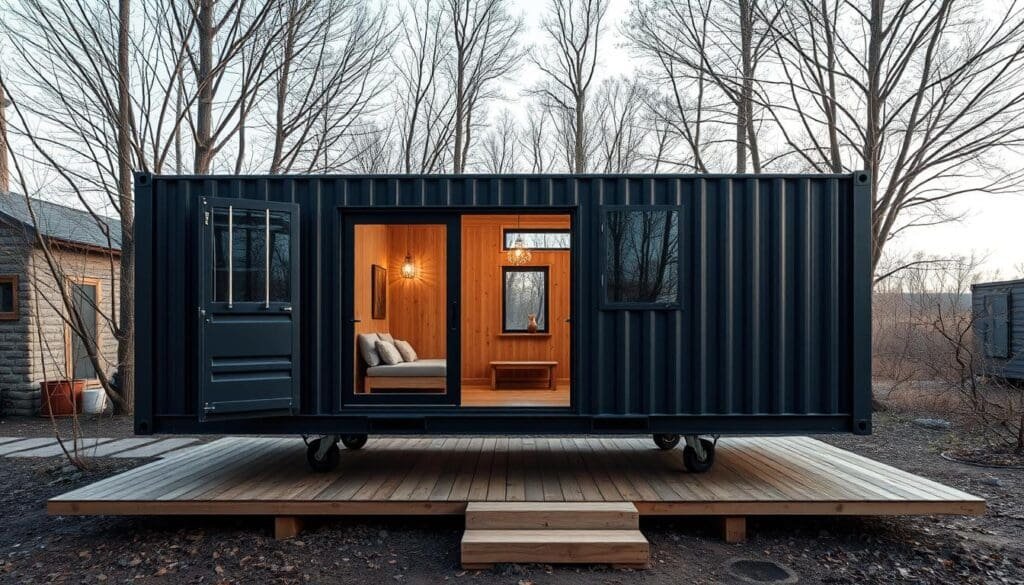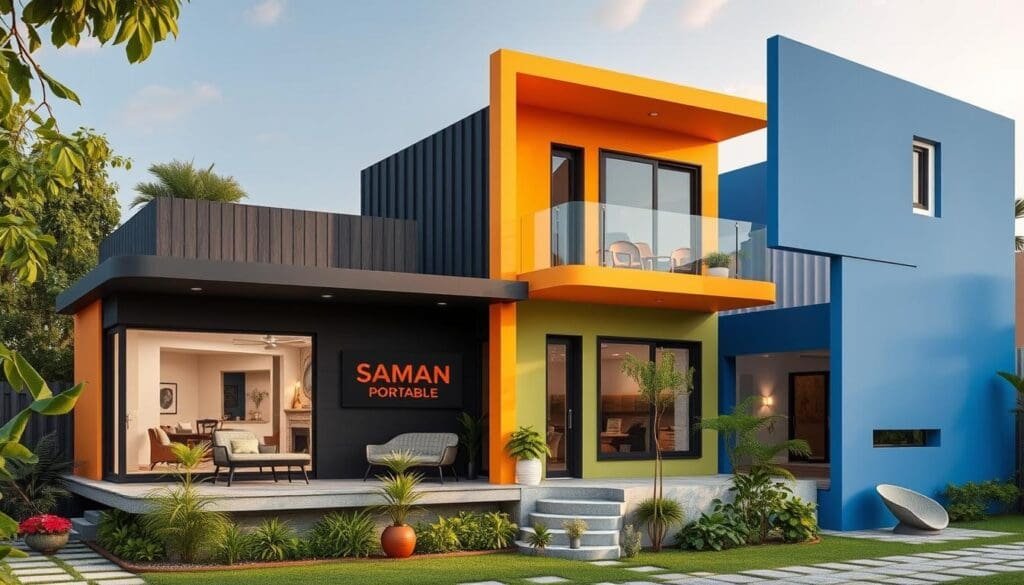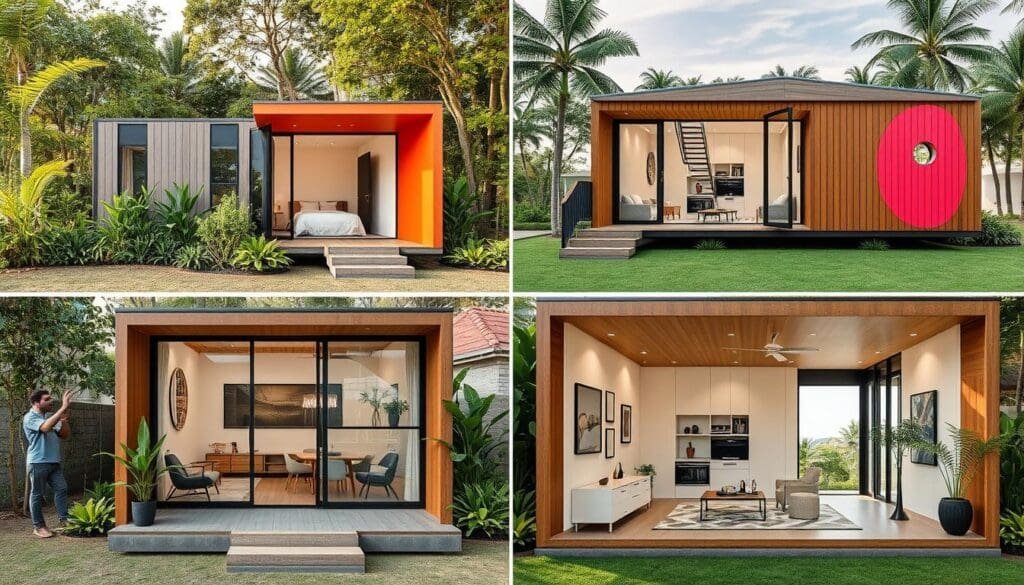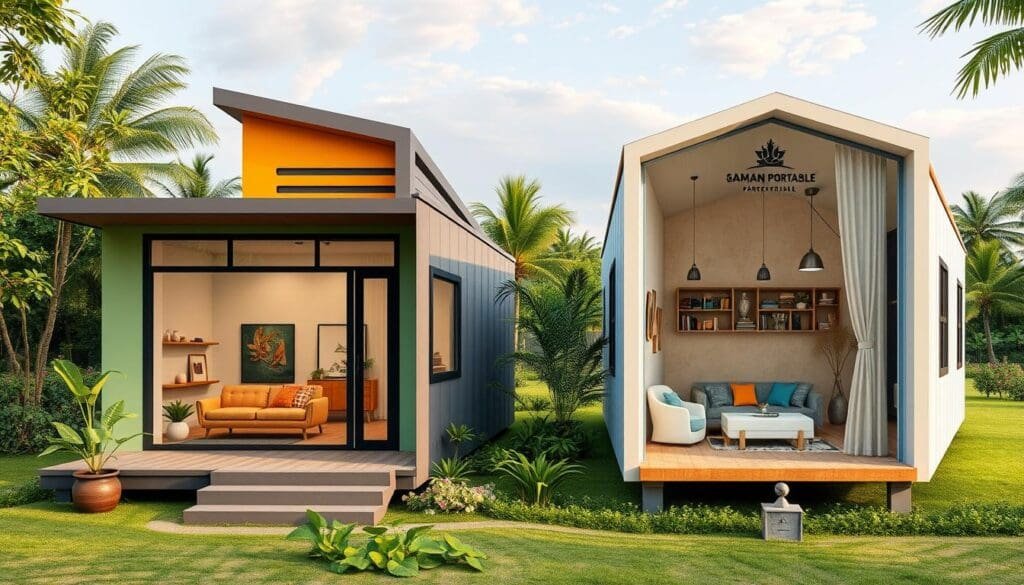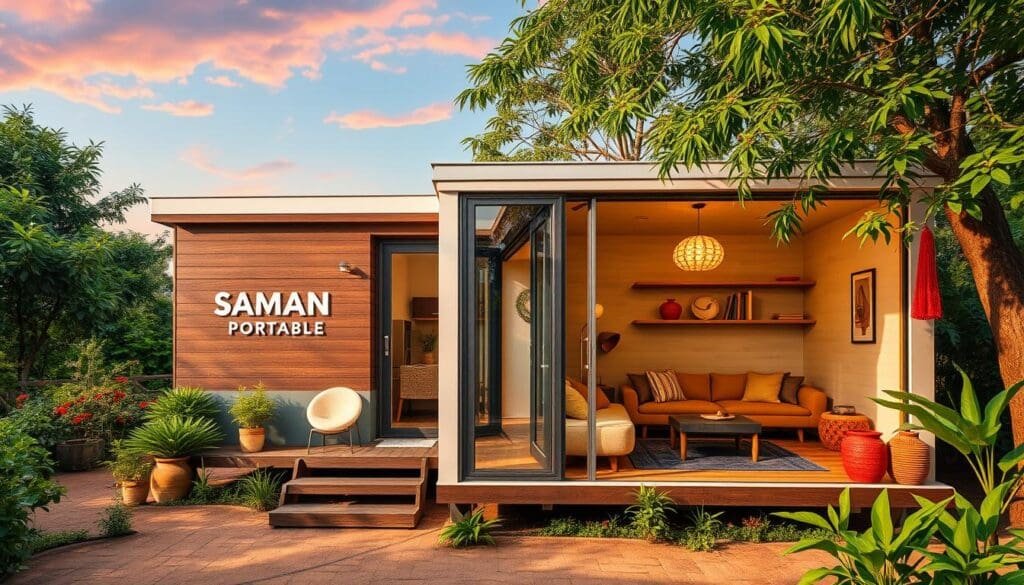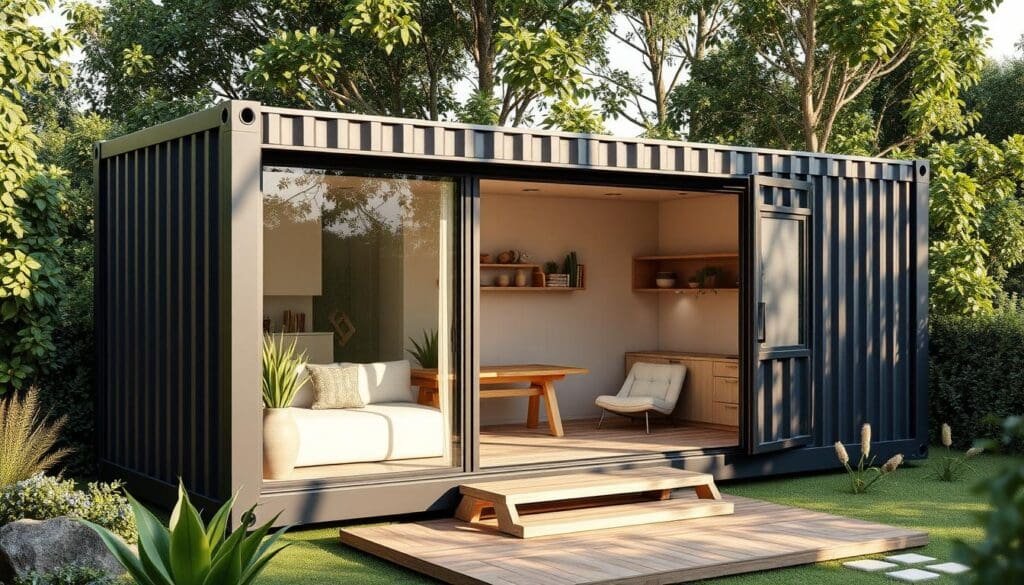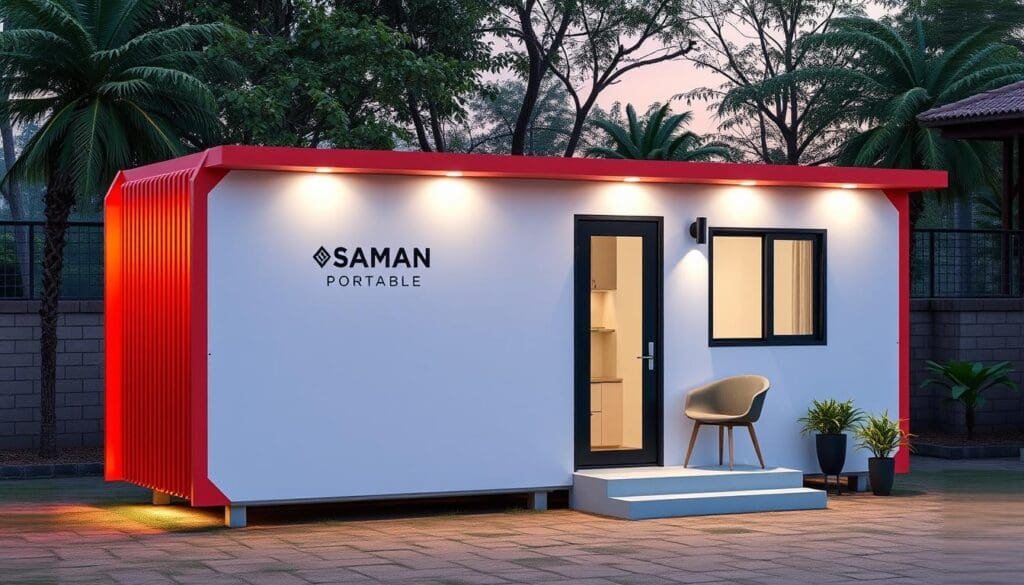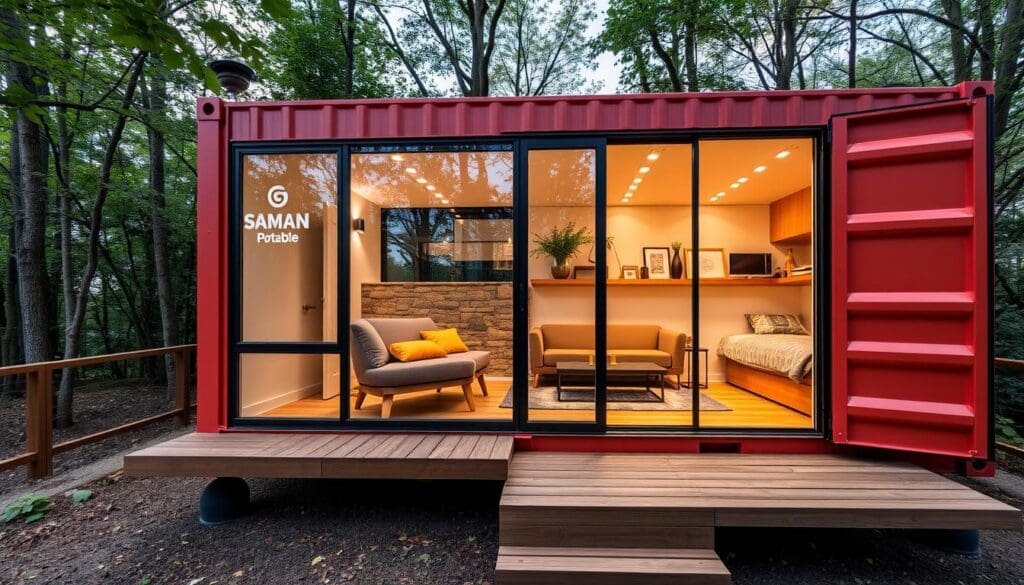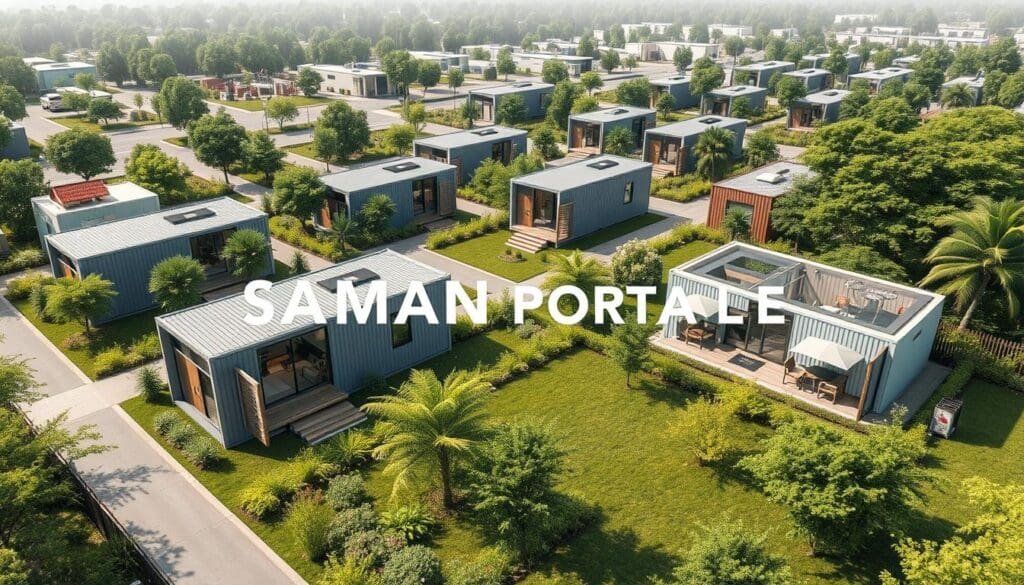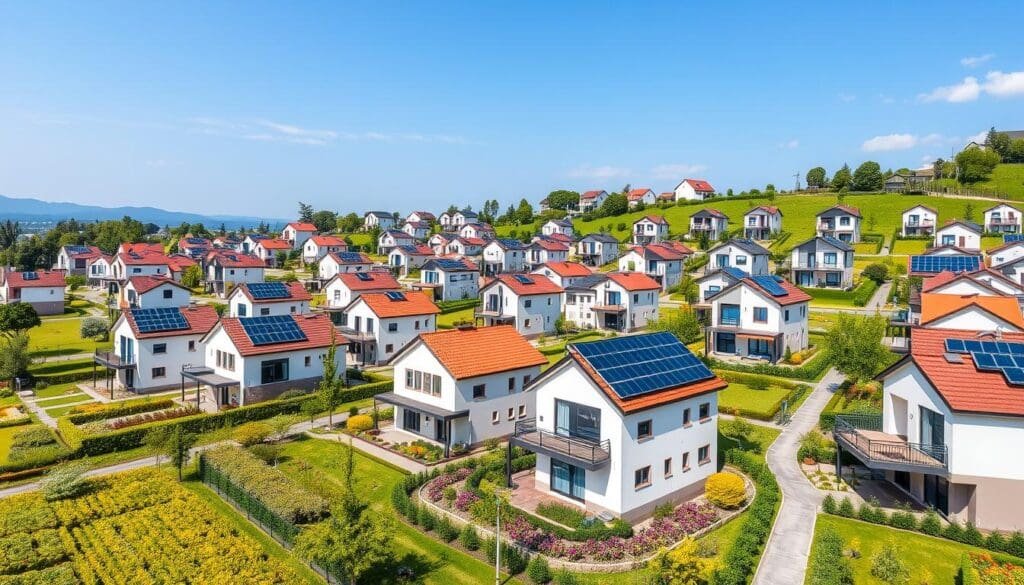Transforming Containers as Homes: Innovative, Affordable, and Sustainable Living Solutions
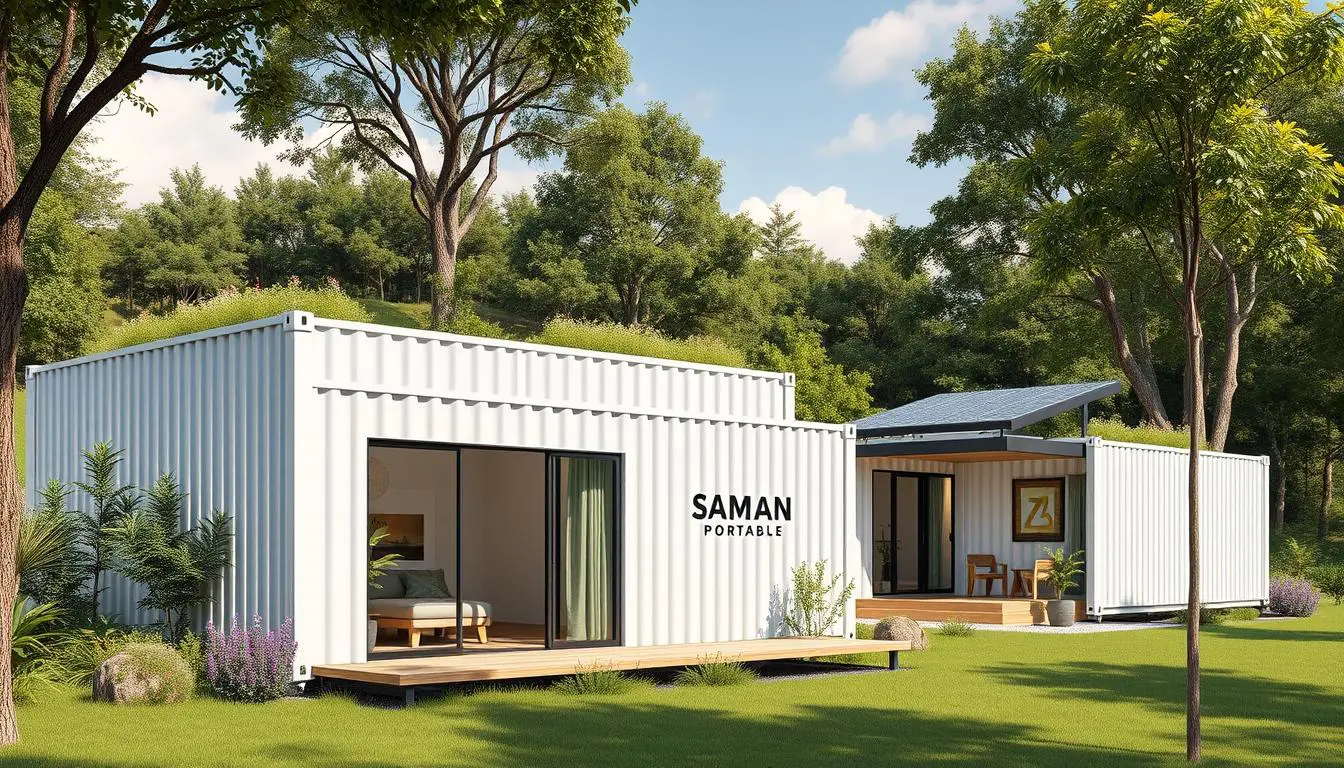
In a world where housing affordability and environmental consciousness are pressing concerns, a revolutionary solution has emerged – containers as homes. Could these repurposed shipping containers hold the key to unlocking a future of innovative, budget-friendly, and sustainable living? As the architectural landscape evolves, the rise of container homes challenges conventional notions about modern dwellings.
What if we told you that a home built from shipping containers could be significantly more cost-effective than traditional construction methods? Beyond the financial advantages, these container-based structures also offer a unique blend of design flexibility, durability, and eco-friendly features. Could this be the solution to the growing demand for affordable and environmentally conscious housing?
Key Takeaways
- Container homes offer a cost-effective and sustainable alternative to traditional housing
- Repurposed shipping containers can be transformed into comfortable living spaces in a matter of weeks
- Container homes contribute to recycling efforts and promote a minimalist lifestyle
- Versatile design options allow for customization and unique architectural features
- Container homes can integrate energy-efficient technologies for off-grid living
Understanding the Evolution of Container Housing
The concept of container architecture has its origins in the repurposing of shipping containers for habitation. These ubiquitous steel boxes, originally designed for the efficient transportation of goods, have evolved into innovative, affordable, and sustainable living solutions. The global adoption of container homes has steadily grown, reflecting a shift towards more versatile and adaptable housing options that cater to contemporary lifestyles and environmental concerns.
Origins of Container Architecture
The first official record of a shipping container home dates back to November 1987, when Phillip Clark patented the “method for converting one or more steel shipping containers into a habitable building.” This pioneering move paved the way for the subsequent rise of container architecture. In 1994, the publication of Stewart Brand’s book “How Buildings Learn” further highlighted the potential of repurposing shipping containers for alternative uses, marking a significant milestone in the evolution of this niche industry.
Global Adoption and Growth
As the concept of container homes gained momentum, the adoption of this innovative approach spread globally. In 1998, the Simon’s Town High School Hostel in South Africa became the first building entirely constructed from shipping containers, accommodating up to 120 individuals. The first shipping container home in the United States was completed in 2007 by architect Peter DeMaria in California, further fueling the interest in container types in shipping. The Graceville Container House, a 6,000 square foot mansion constructed from 31 shipping containers in Australia, gained widespread attention in 2012, showcasing the versatility and potential of different types of containers in residential applications.
Modern Applications in Housing
The rise of the tiny home movement, popularized by TV shows such as “Tiny House, Big Living” and “Tiny House Hunters” in 2014, has significantly boosted the types of containerization industry, highlighting the affordability and ease of converting containers into compact yet functional living spaces. Today, container homes can be found in a variety of configurations, from single-unit dwellings to multi-container complexes, seamlessly integrating into both urban and rural settings and offering innovative design solutions to meet the evolving needs of modern living.

Benefits of Choosing Containers as Homes
Eco-friendly container houses are emerging as innovative and sustainable living solutions. These durable housing options offer a range of benefits that make them an attractive choice for homeowners seeking stylish and affordable homes. From cost-effectiveness to environmental responsibility, container homes present a compelling alternative to traditional construction.
One of the primary advantages of container homes is their cost-effectiveness. The average cost to build a shipping container home can range from as low as $10,000 to $35,000, significantly lower than the average price of a traditional house. This affordability makes homeownership more accessible, particularly for first-time buyers or those on a budget. Additionally, the long-term maintenance costs of container homes are often lower, further enhancing their financial appeal.
- Cost-effective construction, with an average range of $10,000 to $35,000
- Reduced long-term maintenance expenses
- Opportunity for customizable, stylish designs
- Modular and relocatable nature for added flexibility
- Eco-friendly and sustainable approach to housing
Beyond the financial advantages, container homes also offer environmental benefits. By repurposing existing steel structures, these innovative housing solutions contribute to a more sustainable future. The use of recycled materials and the energy-efficient design of container homes help reduce their carbon footprint, making them an ideal choice for eco-conscious individuals seeking durable, yet stylish, living spaces.

Moreover, the modular and relocatable nature of container homes provides homeowners with greater flexibility. The ability to easily expand or relocate these structures allows for adaptability to changing needs and preferences. This versatility, combined with the opportunity for customizable designs, empowers homeowners to create truly unique and personalized living spaces.
In conclusion, the benefits of choosing containers as homes extend beyond just cost-savings. These innovative housing solutions offer an eco-friendly, durable, and customizable alternative to traditional construction, making them an increasingly popular choice for homeowners seeking stylish and sustainable living options.
Cost-Effectiveness and Financial Advantages
When it comes to affordable prefab houses and cost-effective housing solutions, shipping containers for homes stand out as a compelling option. The initial investment for container homes is significantly lower compared to traditional construction methods. In fact, the average starting price for container homes at Bob’s Containers is around $40,000, providing a baseline budget entry point for potential homeowners under $50,000.
Beyond the upfront cost savings, container homes also offer long-term financial advantages. Their durable steel construction and modular design lead to reduced maintenance costs, enhanced energy efficiency, and the potential for lower insurance premiums. While navigating zoning laws and building codes may present some challenges, the overall cost-effectiveness of container homes is a major draw for those seeking innovative and sustainable living solutions.
Return on Investment Potential
The modular nature of container homes allows for phased construction, spreading the costs over time and enabling a gradual expansion of living space as needs evolve. This flexibility can translate into an impressive return on investment, as container homes can be easily modified or expanded to increase their market value. The container home industry is evolving rapidly, with companies like Tempohousing showcasing high-efficiency living spaces achievable through container construction.
Long-term Maintenance Costs
The steel composition of container homes enhances their longevity and resilience, reducing the need for frequent repairs and replacements. Container homes’ steel composition enhances longevity and resilience, minimizing the need for costly maintenance over time. This translates into significant long-term savings, making them a cost-effective housing solution that can withstand the test of time.
Sustainable Living Through Container Housing
In the realm of eco-friendly and sustainable living solutions, container homes are emerging as innovative alternatives that challenge traditional notions of residential architecture. These repurposed shipping containers are not only affordable but also embody principles of environmental stewardship, making them an increasingly attractive option for those seeking sustainable lifestyles.
The compact nature of container homes encourages a minimalist lifestyle, reducing overall environmental impact. These structures can be easily outfitted with renewable energy systems, such as solar panels, to further enhance their sustainability. The longevity of container homes also contributes to long-term environmental conservation, as they reduce the need for frequent rebuilding or renovations.
- Container homes repurpose existing materials, reducing construction waste and promoting eco-friendly practices.
- Compact design and energy-efficient features like solar panels make container homes a sustainable living choice.
- The modular construction of container homes allows for efficient use of space and creative design solutions.
As the demand for sustainable office designs and eco-friendly container houses continues to rise, the container housing industry is experiencing rapid growth. Investments in research and development are crucial for driving innovation in container home designs, materials, and construction methodologies, aiming to reduce costs while enhancing overall appeal and functionality.

With their financial benefits, energy efficiency, and reduced environmental impact, container homes are poised to play a significant role in the future of sustainable living. By embracing this innovative approach to housing, individuals and communities can contribute to the larger goal of creating a more eco-friendly and resource-conscious built environment.
Design Possibilities and Architectural Innovation
The world of customizable container homes is bursting with design possibilities and architectural innovation. Architects and designers are pushing the boundaries of what can be achieved within the constraints of container dimensions, creating modern office spaces and efficient container offices that redefine the way we live and work.
Interior Layout Options
Interior layouts in container homes can be expertly tailored to maximize space efficiency and functionality. From open-concept floor plans that enhance airiness and natural lighting to strategic placement of walls and partitions, the modular nature of containers allows for a wide range of customizable configurations. Creative storage solutions, such as hidden cabinets and built-in shelving, further optimize the use of available space.
Exterior Modifications
The exterior of container homes can also undergo remarkable transformations, allowing for the integration of innovative design elements. Architects are experimenting with creative façade treatments, incorporating renewable energy sources like solar panels and integrating outdoor living spaces like balconies and terraces. These exterior modifications not only enhance the visual appeal of the customizable container homes but also contribute to their sustainability and energy efficiency.
Multi-Container Configurations
- The modular design of containers enables the creation of larger, more complex structures through the use of multiple units.
- Innovative stacking and arrangement options allow for the construction of multi-story modern office spaces and efficient container offices.
- These multi-container configurations unlock a world of possibilities, from spacious open-plan layouts to unique architectural forms that challenge traditional building norms.
The potential for design exploration and architectural innovation in the realm of container homes is truly limitless. By embracing the inherent flexibility of these modular structures, designers and architects are redefining the boundaries of sustainable and functional living spaces.

Construction Process and Timeline
When it comes to building portable office containers, the construction process is significantly faster than traditional building methods. The streamlined approach of using pre-fabricated portable office containers allows for a more efficient and expedited timeline, from design to completion.
The first step involves site preparation and foundation work, which can be completed concurrently while the office containers for sale are being modified off-site. The assembly of these pre-fabricated container units on-site is quick and seamless, thanks to the precise engineering and design.
The incorporation of electrical, plumbing, and HVAC systems within the containers prior to delivery further reduces the on-site construction time. This integrated approach enables a faster turnaround, often completing the entire project in a matter of weeks or months, depending on the complexity of the design and the containers for office requirements.
- Planning the project: Approximately 6 weeks
- Finalizing design and obtaining approvals: 9-12 weeks
- Site preparation and foundations: 4-7 weeks
- Placing and modifying containers: 3-9 weeks
- Finishing for occupancy: 2-13 weeks
This expedited timeline results in reduced labor costs and earlier occupancy, making portable office containers a compelling choice for businesses and organizations seeking efficient, cost-effective, and sustainable workspace solutions.

Legal Considerations and Building Regulations
As the popularity of container homes continues to rise, it’s crucial to navigate the legal landscape and adhere to building regulations. In India, the National Building Code (NBC) serves as a comprehensive guideline for various aspects of construction, including the use of shipping containers for residential purposes. While the code does not have specific regulations addressing container homes directly, it provides a framework for ensuring the structural integrity, safety, and compliance of these innovative living solutions.
Shipping containers are designed to withstand harsh environmental conditions and carry heavy loads, making them inherently sturdy. However, to meet local building codes and regulations, container homes may require additional structural reinforcement, proper insulation, and specialized ventilation systems. Consultation with local authorities is essential to understand zoning requirements that govern land use and specify the types of buildings permitted in specific areas.
Zoning Requirements
The legality of container homes in India is currently a grey area, with the importance of design, construction, and adherence to building codes emphasized for compliance and safety. Zoning laws can significantly impact the feasibility of building container homes, and knowledge of zoning classifications is crucial for compliance. Residential zones often have specific building standards, including height restrictions and green space requirements, which must be carefully considered.
Permits and Approvals
Obtaining the necessary permits and approvals for container homes can be a complex process due to their unconventional nature. Detailed architectural plans and compliance with local building codes are typically required to secure permits for construction. Regulatory authorities will also conduct inspections throughout the building process to verify adherence to approved plans and safety standards.
Safety Standards
Container homes must meet rigorous safety standards to ensure the structural integrity, fire resistance, and overall occupant health and well-being. Modifications to the container structure, such as reinforcement, insulation, and ventilation, are essential to comply with building codes and create a safe living environment. Engaging experienced professionals, such as structural engineers and architects, is recommended to navigate the legal and safety requirements for container home projects.

As the demand for sustainable and affordable housing options in India continues to grow, the potential for container homes to address these needs is becoming increasingly evident. However, it is crucial for homeowners and developers to work closely with local authorities and adhere to all legal and safety requirements to ensure the successful and compliant construction of these innovative living spaces.
Container Home Customization Options
Transforming shipping containers into stylish and functional homes has become an increasingly popular trend, offering a world of customization possibilities. Whether you’re seeking an affordable office option or dreaming of a unique, sustainable living space, container homes provide a versatile canvas for personalization.
The modular nature of container workspaces allows for a wide range of interior finishes, from industrial-chic to luxurious. Homeowners can choose from a variety of materials and design styles to create their desired aesthetic. Exterior cladding options, such as wood, metal, or even living walls, can further enhance the visual appeal of the container home.
- Customizable floor plans and layout options to maximize space efficiency
- Incorporation of energy-efficient features, smart home technologies, and renewable energy sources
- Seamless integration of outdoor living spaces, including rooftop gardens, balconies, and patios
The modular nature of container homes also enables homeowners to easily expand or reconfigure their living spaces as their needs evolve. Whether it’s a compact, single-unit design or a multi-container configuration, the possibilities for creating a truly unique and affordable office options are endless.

By embracing the concept of stylish container homes, homeowners can not only enjoy a customized living experience but also contribute to a more sustainable future. The repurposing of shipping containers reduces waste and promotes eco-friendly practices, making container homes a remarkable choice for those seeking innovative and affordable office options.
Environmental Impact and Eco-friendly Features
Container homes have a remarkable positive impact on the environment. By repurposing existing shipping containers, these innovative housing solutions significantly reduce waste and the demand for new construction materials. Traditional building methods often require vast resources like wood, bricks, and cement, but container homes make use of the existing steel structures, conserving natural resources and minimizing the carbon footprint.
Energy Efficiency Solutions
Shipping container homes are designed with energy efficiency in mind. Many feature advanced insulation techniques and passive solar design, allowing for comfortable indoor temperatures with minimal heating or cooling requirements. Solar panels are commonly integrated, harnessing renewable energy to power these eco-friendly container houses. The use of large windows and skylights also reduces the need for artificial lighting, further contributing to the sustainable office designs and eco-friendly container houses.
Waste Reduction Benefits
Container homes offer a sustainable solution by repurposing and upcycling existing structures. This approach significantly reduces the demand for new construction materials, cutting harmful carbon dioxide emissions. Additionally, the modular design of container homes allows for flexibility and adaptability over time, minimizing resource consumption compared to traditional buildings. The integration of renewable energy sources, such as solar panels and wind turbines, further enhances the innovative housing solutions offered by container homes.
Sustainable living practices are at the core of container home design. From water-efficient plumbing to rooftop gardens, these eco-friendly features showcase the commitment to environmental responsibility and resource conservation. By embracing the versatility and durability of shipping containers, container homes set a new standard for sustainable office designs and eco-friendly container houses.

Integration in Urban and Rural Settings
As the demand for affordable and sustainable housing solutions continues to grow, modern container homes have emerged as a versatile option that can be seamlessly integrated into both urban and rural environments. These innovative modern container homes offer a range of benefits, from cost-effectiveness to eco-friendly features, making them an attractive choice for a variety of living situations.
In urban areas, container housing solutions provide creative solutions to address housing shortages and infill development challenges. These compact and modular structures can be utilized for temporary housing, emergency accommodations, student dormitories, or affordable housing projects. Their adaptability allows them to be easily integrated into dense urban landscapes, maximizing the utilization of limited space.
On the other hand, affordable prefab houses made from repurposed shipping containers have found their place in rural settings as well. These sustainable dwellings offer off-grid living opportunities, catering to the growing demand for eco-tourism and self-sufficient lifestyles. The versatility of container homes enables them to withstand diverse climatic conditions, making them suitable for a wide range of rural locations.
Whether in urban centers or remote rural areas, the integration of container homes has the potential to address housing challenges, promote sustainable living, and provide innovative solutions to meet the evolving needs of communities. As the popularity of this architectural trend continues to rise, the integration of modern container homes into various settings is poised to transform the landscape of both urban and rural living.

Durability and Weather Resistance
Shipping containers are inherently durable, making them an excellent choice for durable housing options. Their steel construction allows them to withstand extreme weather conditions, including high winds, heavy rain, and snow loads. The corrosion-resistant properties of the steel contribute to the longevity of shipping containers for homes and containers as homes.
Proper insulation and ventilation systems ensure that container homes remain comfortable in various climates. The structural integrity of the containers provides excellent protection against natural disasters, such as hurricanes and tornadoes. With proper maintenance, container homes can have a lifespan comparable to or even exceeding that of traditional houses, reducing the need for frequent repairs and replacements.
- Shipping container homes can withstand winds up to 175 mph during hurricane season, making them safer than many traditional buildings.
- The load-bearing capacity of a container can reach up to 215 pounds per square foot on its corner posts, making them suitable for heavy snowfall areas.
- Shipping container homes excel during flood seasons as they can be elevated on sturdy foundations to keep living spaces above flood levels.
- Proper waterproofing and reinforcement against snow loads are essential considerations for container homes in snowy areas.
The durability of container homes is a testament to the innovative design and construction techniques used in their development. By leveraging the inherent strength and weather-resistant properties of shipping containers, these structures offer a reliable and cost-effective alternative to traditional housing options.
With proper maintenance and strategic placement, containers as homes can withstand the harshest of weather conditions, providing residents with a safe and secure living environment. The versatility and resilience of container homes make them an attractive option for those seeking durable and sustainable housing solutions.
Market Trends and Future Prospects
The innovative container home market is experiencing significant growth globally. Investment opportunities exist in both residential and commercial applications of this versatile architectural solution. Industry growth predictions indicate a continued increase in demand for sustainable and affordable prefab houses.
The adaptability of modern container homes to various markets and demographics contributes to their vast market potential. Technological advancements in prefabrication and modular construction are expected to further enhance the efficiency and appeal of these innovative housing solutions. The growing emphasis on sustainable living and eco-friendly construction practices supports the long-term prospects of the container home industry.
Investment Opportunities
The global container homes market was valued at USD 61.83 billion in 2023 and is projected to grow to USD 108.70 billion by 2032, exhibiting a CAGR of 6.7% during the forecast period. This growth trajectory presents lucrative investment opportunities for both residential and commercial applications of container architecture.
Industry Growth Predictions
- The container homes market in the U.S. is expected to reach USD 42.67 billion by 2032, attributed to the demand for innovative architectural design.
- The COVID-19 pandemic temporarily impacted the container home market, but the demand for prefabricated houses is increasing due to post-pandemic trends.
- Container homes are gaining popularity globally due to their affordability, sustainability, and eco-friendly materials, with companies like Honomobo leading the way in modern building techniques.
The future of the container home industry looks promising, with advancements in construction methods, growing emphasis on sustainable living, and the increasing need for cost-effective and adaptable housing solutions.
Conclusion
Container homes represent a transformative approach to housing, offering innovative, affordable, and sustainable living solutions. They address contemporary challenges in housing affordability, environmental sustainability, and design flexibility. The versatility and durability of container homes make them suitable for diverse applications and environments, from residential to commercial use.
As the industry continues to evolve, container homes are poised to play a significant role in shaping the future of residential and commercial architecture in India. The growing adoption of container homes reflects a broader shift towards more sustainable, efficient, and adaptable living spaces in modern society. With their cost-effectiveness, reduced construction timelines, and eco-friendly features, container homes present a promising solution to the housing and environmental challenges faced by communities across India.
Whether it’s affordable housing initiatives, eco-resorts, or commercial spaces, the versatility of container homes is being increasingly explored by developers and architects in India. As the popularity of container houses steadily increases, they have the potential to unlock a new era of sustainable living for future generations, promoting recycling, energy efficiency, and resilience against natural disasters.
FAQ
What are the benefits of choosing container homes?
Container homes offer numerous benefits, including cost-effectiveness, sustainability, and quick construction. They provide an eco-friendly alternative to traditional housing by repurposing existing materials, and their durability ensures long-lasting structures resistant to extreme weather conditions. Container homes also allow for customizable designs and promote spatial efficiency through creative, multi-functional layouts.
How cost-effective are container homes compared to traditional construction?
Container homes offer significant cost savings compared to traditional construction methods. The initial investment is lower due to the availability and affordability of shipping containers, and long-term maintenance costs are reduced due to the durability of steel structures. The modular nature of container homes allows for phased construction, spreading costs over time, and energy-efficient features can lead to lower utility bills.
What are the sustainable features of container homes?
Container homes embody sustainable living principles by repurposing existing materials and reducing construction waste. They promote eco-friendly practices through energy-efficient designs and the use of recycled materials. The compact nature of container homes encourages a minimalist lifestyle, reducing overall environmental impact, and they can be easily outfitted with renewable energy systems to further enhance sustainability.
How versatile are the design possibilities for container homes?
Container homes offer extensive design possibilities and architectural innovation. Interior layouts can be customized to maximize space efficiency and functionality, and exterior modifications allow for creative façade treatments and the integration of outdoor living spaces. Multi-container configurations enable the creation of larger, more complex structures, and architects can explore innovative solutions for lighting, ventilation, and spatial organization within the constraints of container dimensions.
How does the construction process for container homes differ from traditional methods?
The construction process for container homes is significantly faster than traditional building methods. Site preparation and foundation work can be completed while containers are being modified off-site, and the assembly of pre-fabricated container units on-site is quick and efficient. Electrical, plumbing, and HVAC systems can be pre-installed in the containers, reducing on-site construction time, often resulting in the entire process, from design to completion, being accomplished in a matter of weeks or months.
What are the legal considerations and building regulations for container homes?
Container homes must comply with local zoning requirements and building codes. Obtaining necessary permits and approvals can be challenging due to the unconventional nature of these structures, and safety standards for structural integrity, fire resistance, and occupant health must be met. It’s crucial to work with local authorities and experienced professionals to ensure compliance with all legal and safety requirements, including proper insulation, ventilation, and structural modifications.
How customizable are container homes?
Container homes offer extensive customization options to suit individual preferences and needs. Interior finishes can range from industrial chic to luxurious, with a wide variety of materials and design styles available. Exterior cladding options allow for personalization of the home’s appearance, and custom furniture and built-in storage solutions can maximize space efficiency. Additionally, features like rooftop gardens, balconies, and advanced technology integration can be incorporated to enhance comfort and functionality.
How do container homes impact the environment?
Container homes have a positive environmental impact through the reuse of existing materials. Energy efficiency solutions, such as high-performance insulation and passive solar design, contribute to reduced energy consumption. Waste reduction benefits are achieved through minimized construction waste and the potential for off-grid living. Rainwater harvesting systems and greywater recycling can be incorporated to conserve water resources, and the use of sustainable materials for interior finishes and furnishings further reduces environmental impact.
How durable are container homes?
Container homes are inherently durable due to their steel construction. They are resistant to extreme weather conditions, including high winds, heavy rain, and snow loads, and the corrosion-resistant properties of shipping containers contribute to their longevity. Proper insulation and ventilation systems ensure comfort in various climates, and the structural integrity of containers provides excellent protection against natural disasters. With proper maintenance, container homes can have a lifespan comparable to or exceeding that of traditional houses.
What is the future outlook for the container home industry?
The container home market is experiencing significant growth globally, with investment opportunities existing in both residential and commercial applications of container architecture. Industry growth predictions indicate a continued increase in demand for sustainable and affordable housing solutions, and technological advancements in prefabrication and modular construction are expected to further enhance the efficiency and appeal of container homes. The growing emphasis on sustainable living and eco-friendly construction practices supports the long-term prospects of the container home industry.
 Container Cafe
Container Cafe
















































































